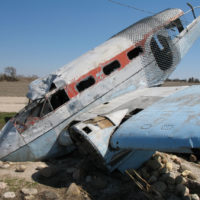Crash En Route to Bay Area Kills Pilot and Two Passengers

A flight bound for San Carlos, California crashed shortly after takeoff on September 11, 2016, killing all three persons on board the aircraft. The reasons for the crash are still under investigation by the National Transportation Safety Board (NTSB).
The plane involved in the crash was a Piper PA-28R-201T, the Turbo Arrow III. The plane took off shortly after 6:00 pm on September 11 from the Reno Airport’s runway 25 under good weather conditions. The plane had registered its flight plan and was destined for the San Carlos Airport, located between San Jose and San Francisco on the San Francisco Peninsula. The purpose of the flight was to return a woman who had skipped bail in California, but had been arrested by a Nevada bail bondsman earlier that day. The woman was shackled to the right rear seat, wearing ankle cuffs, for the flight. The pilot and third passenger were a California bail bondsman and attorney, respectively.
Witnesses observed the plane as it took off, climbing to a height of about 200 feet after rotation. However, the plane failed to climb above this height and began instead to veer toward the right of centerline. When 90 seconds had passed after the tower controller gave the pilot takeoff clearance, but the plane had failed to gain any altitude, the controller reached out to the pilot. According to the NTSB’s report, the tower controller asked, “Are you ok?” The pilot replied, “Negative we got ah, we got a problem.”
Unfortunately, the controller was unable to communicate further with the pilot. Based on the NTSB’s review of radar data and security camera footage from the tarmac, the Piper remained at the same altitude. The plane traveled to the right of the runway’s centerline by 1,500 feet, and attempted to turn back toward the airport. Roughly 600 feet before the Piper arrived at the main terminal ramp, the plane’s right wing clipped a lamp post in the airport’s parking lot. At this point, the wing’s outboard portion was torn from the plane, causing the plane to roll to the right into the cars parked below, damaging fifteen cars in the process. Upon making impact, the plane took crush damage through to the aircraft’s vertical stabilizer. Both the wing and engine became detached from the plane, but all parts of the plane were recovered by investigators. The reasons for the plane’s failure to take off are not yet known.
If you’ve been injured in a California plane crash or other aviation accident, and believe you may be entitled to money damages for your injuries, contact the knowledgeable and effective Los Angeles aviation accident attorneys at Magaña, Cathcart & McCarthy for a consultation on your claims, at 310-553-6630.


 Close Menu
Close Menu